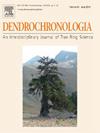Concatenating latewood blue intensity and wood anatomical sensitivity in Neotropical montane podocarps: How does sex-related climate trigger tracheid plasticity?
IF 2.7
3区 农林科学
Q1 FORESTRY
引用次数: 0
Abstract
Increased hydric stress may result in a reshaping of tree species distribution in moist environments. Dioecious tree species may be more vulnerable to climate warming if sex-related sensitivity to drought occurs since lower performance of one sex may drive differential stress tolerance and sex-related mortality rates. We assessed sex-related differences in Neotropical montane podocarps (Podocarpus matudae subsp. matudae) Latewood Blue Intensity (LWBI) and tracheid anatomical plasticity, including lumen radial diameter, wall tangential thickness, cell radial diameter, Mork's index, and hydraulic efficiency and safety. We hypothesized that podocarp latewood growth shows increasing sensitivity to extreme climatic events (i.e. the wettest and driest years), and that the anatomical adaptation (phenotypic plasticity) of the latewood tracheids is influenced identically by limiting climatic factors in both sexes. In addition, this study aimed to 1) test podocarp sex-related differences in LWBI chronology and regional climate sensitivity, as well as spatial signatures of these relationships; 2) assess the influence of climate on tracheid anatomical features between female and male podocarps; and 3) evaluate wood anatomical adaptation between female and male podocarps in the historically wettest and driest years. The responses of the LWBI to the local mean maximum temperature, minimum temperature, and monthly precipitation showed sex-related differences. Specifically, sex differences in LWBI chronology demonstrated dissimilar spatial precipitation signals across Tropical Montane Cloud Forests. Female and male latewood tracheid traits show high anatomical plasticity associated with hydraulic efficiency, which is essential for understanding the resilience of tropical dioecious conifers in moist slope environments. Our results provide insights into how sex differences in LWBI chronologies and sex tracheid anatomical traits may be differentially adapted to wetter and drier climates.
连接新热带山地足足鱼的晚木蓝强度和木材解剖敏感性:性别相关气候如何触发管胞可塑性?
水分胁迫的增加可能导致潮湿环境中树种分布的重塑。如果雌雄异株树种对干旱的敏感性与性别有关,那么它们可能更容易受到气候变暖的影响,因为一种性别的较低表现可能导致不同的抗逆性和性别相关的死亡率。我们评估了新热带山地足carps (Podocarpus matudae subsp)的性别相关差异。拉特伍德蓝强度(LWBI)与气管解剖可塑性的关系,包括管腔径向直径、管壁切向厚度、细胞径向直径、莫克指数、水力效率和安全性。我们假设,足尾木的生长对极端气候事件(即最潮湿和最干燥的年份)的敏感性越来越高,并且足尾木管管的解剖适应性(表型可塑性)在两性中同样受到限制性气候因素的影响。此外,本研究旨在1)测试足鲤性别相关的LWBI年代学和区域气候敏感性差异,以及这些关系的空间特征;2)评估气候对雌雄豆科鱼气管解剖特征的影响;3)评价历史上最湿和最干年份雌、雄足跖鱼的木材解剖适应性。LWBI对当地平均最高气温、最低气温和月降水量的响应存在性别差异。具体而言,LWBI年代学的性别差异显示了热带山地云雾林不同的空间降水信号。雌雄晚枝针叶树管胞的解剖可塑性与水力效率密切相关,这对理解热带雌雄异株针叶树在湿润斜坡环境中的恢复力具有重要意义。我们的研究结果为LWBI年代学和性别气管解剖特征的性别差异如何适应潮湿和干燥气候提供了见解。
本文章由计算机程序翻译,如有差异,请以英文原文为准。
求助全文
约1分钟内获得全文
求助全文
来源期刊

Dendrochronologia
FORESTRY-GEOGRAPHY, PHYSICAL
CiteScore
5.50
自引率
13.30%
发文量
82
审稿时长
22.8 weeks
期刊介绍:
Dendrochronologia is a peer-reviewed international scholarly journal that presents high-quality research related to growth rings of woody plants, i.e., trees and shrubs, and the application of tree-ring studies.
The areas covered by the journal include, but are not limited to:
Archaeology
Botany
Climatology
Ecology
Forestry
Geology
Hydrology
Original research articles, reviews, communications, technical notes and personal notes are considered for publication.
 求助内容:
求助内容: 应助结果提醒方式:
应助结果提醒方式:


